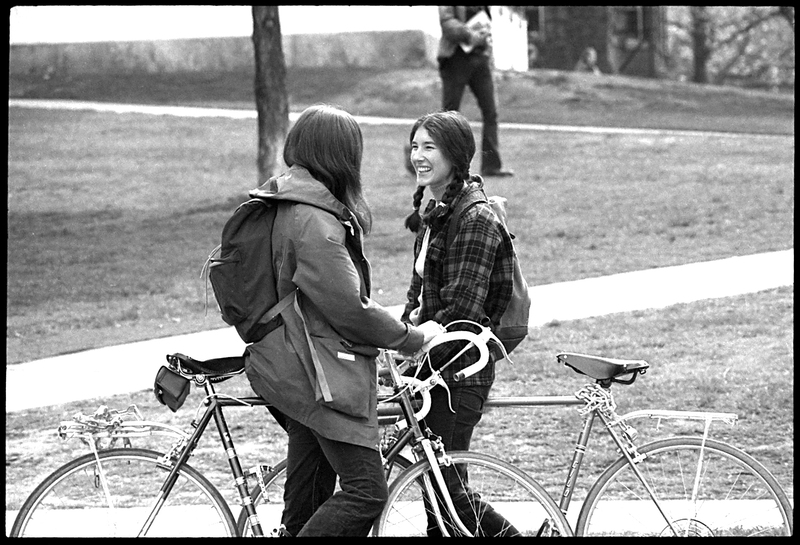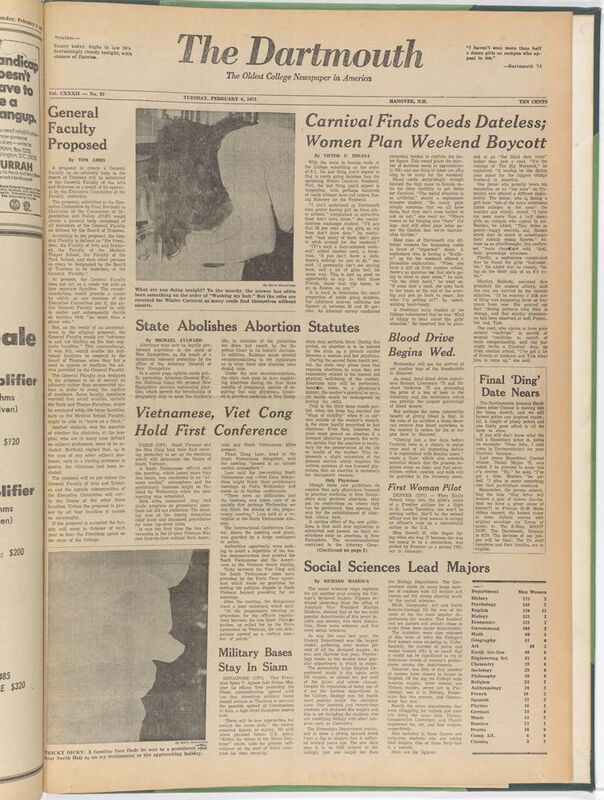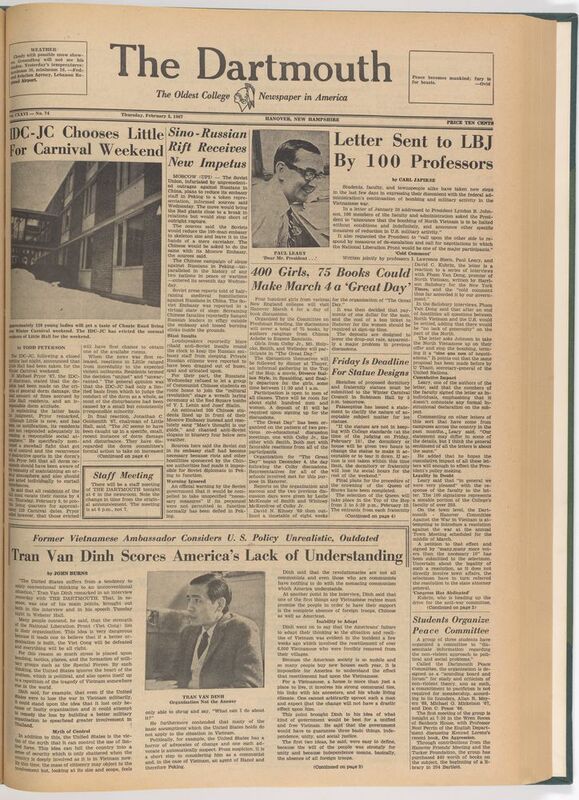-

Women students on Freshman Trip, 1972
-

Despite these negative events, many of the women in the first classes later reported their pleasure at being at Dartmouth whether it was for their final year in higher education or if they entered as freshmen with the class of 1976.
-

Women students at the time recounted having snowballs with rocks thrown at them and being rated on a scale of 1-10 as they approached the dining hall. In April highly offensive letters were shoved under the doors of women living in Woodward Hall that referred to the women students as “cohogs.”
-

Things got off to a rocky start right early on when on September 26, a group of male students invaded Woodward Hall, an all women dormitory. They shouted rude comments, seized one woman and began to carry her away, and damaged property until the police were called. The students in Woodward noted that this was not the first instance of harassment at the time. Feeling the need for solidarity in the face of these attacks a group of women formed a new student organization Women of Dartmouth.
-

Lorna Hill is likely the first woman to complete her degree requirements at Dartmouth.
-

An article in The Dartmouth titled “Carnival Finds Most Coeds Dateless; Women Plan Weekend Boycott" resulted in a number of vitriolic exchanges between men and women students via letters to the editor.
-

Women arrived on campus on September 5, 1972.
-

What was most notable about the Alumni response to the survey is that while the majority were pro-coeducation, the feeling of the two camps, pro and con, were deeply entrenched in their stances. It is also important to note that the older alumni were the least in favor of coeducation.
-

Despite stiff resistance by some members and an attempt by the Chair to postpone the implementation of coeduction, on November 21 the Trustees voted unanimously for Year Round Operation and by a majority to integrate women into the College begin in September of 1972.
-

On September 24 1971, the Committee on Year Round Operation submitted its report to the Trustees. The Committee presented six recommendations related to Year Round Operation (later known as the Dartmouth Plan). They also provided three recommendations related to coeducation that flew in the face of what the Trustees had discussed. The first of these was that the College should begin matriculating women in September of 1972.The second was that the enrollment should aim for 3,000 men and 1,000 women (the Trustees were hoping for smaller ratio of women to men) and finally that the physical plant of the College should be expanded to accommodate 3.400 undergraduates. On October 9, the Trustees voted to accept the principles laid out in the Committee’s report. This indicated a major shift in the Board’s thinking.
-

While the Board wished to pursue an associated school for women, the faculty, following the lead of the women faculty and women exchange students on campus who saw the associated school as separate and unequal, voted for full integration.
-

The faculty were in favor of coeducation as were a majority of students. While the overwhelming majority of students, 82%, favored coeducation, what is not clear from this survey, and would raise a dark cloud over the first year of coeducation, was that the 14% of students opposed to coeducation constituted 526 students. Although a minority, 526 students is still a large number of individuals opposed to coeducation.
-

The divided opinion regarding coeducation among alumni based on their age is important to note because the Board was made up primarily of the classes from the 1920s, which were among the classes most opposed to coeducation.
-

The Quayle report outlined the responses to the survey that Kemeny commissioned. The survey focused on the alumni and faculty and was conducted by a professional, outside firm run by Oliver Quayle, class of 1942. It also included the results of a separate survey conducted with students.
-

In January of 1970 the Trustees elected John Kemeny to the President of the College. Kemeny was an outspoken proponent of coeducation, so with his election the Trustees signaled their willingness to at least explore admitting women to Dartmouth.
-

Three women exchange students who arrived on campus during the 1969-70 school year. From left to right: Gayle Williamson (Randolph-Macon College), Elizabeth Heaps (Connecticut College), Dr. Mary Frances Stubbs (Talladega College).
-

Under pressure from the students, the administration agreed to admit 70 women as part of the 10 College Exchange Notable among these early attendees was Meryl Streep.
-

In keeping with the anti-establishment spirit of the 1960s some students even organized protests on The Green.
-

Students holding a discussion during Great Day
-

One of the earliest acts by the students to push coeducation was The Great Day. The Great Day invited 400 women from other institutions, mostly the Seven Sisters (which included schools like Smith, Mount Holyoke, Vassar and Wellesley), to come to Dartmouth to participate in a day of coed book discussions. It was a kind of dry run for what it would be like to have women on campus and in the classroom. That same year the students established the Ad Hoc Committee on Coeducation a joint student/faculty committee to study coeducation at Dartmouth.
-

In 1867 The Dartmouth published an article about a visit to Vassar, which at the time was a college for women. They closed their article with the expectation that women would soon grace the halls of Dartmouth, but they were a bit premature since it would be over 100 years before women would matriculate at Dartmouth.





















